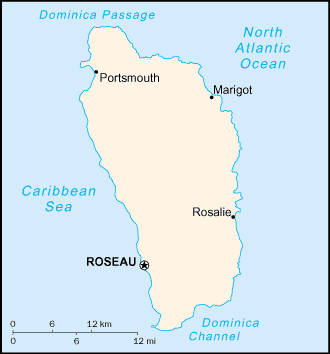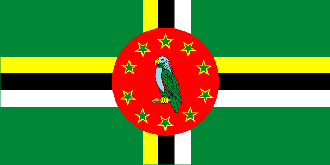
|
Dominica
Background:
Dominica was the last of the Caribbean islands to be colonized by
Europeans, due chiefly to the fierce resistance of the native Caribs. France
ceded possession to Great Britain in 1763, which made the island a colony in
1805. In 1980, two years after independence, Dominica's fortunes improved when
a corrupt and tyrannical administration was replaced by that of Mary Eugenia
Charles, the first female prime minister in the Caribbean, who remained in
office for 15 years.
Location:
Caribbean, island between the Caribbean Sea and the North Atlantic
Ocean, about one-half of the way from Puerto Rico to Trinidad and Tobago.
Area: Total: 754 sq km.
Area - comparative: Slightly more than four times the size of Washington, DC.
Coastline: 148 km.
Climate and Terrain:
Climate: Tropical; moderated by northeast trade winds; heavy rainfall.
Terrain: Rugged mountains of volcanic origin.
Elevation extremes: Lowest point: Caribbean Sea 0 m, highest point: Morne
Diablatins 1,447 m.
Natural resources: Timber, hydropower, arable land.
Land use: Arable land: 9%, permanent crops: 13%, forests and woodland: 67%.
People:
Population: 70,786.
Ethnic groups: Black, Carib Amerindian.
Religions: Roman Catholic 77%, Protestant 15% (Methodist 5%, Pentecostal 3%,
Seventh-Day Adventist 3%, Baptist 2%, other 2%), none 2%, other 6%
Languages: English (official), French patois.
Government:
Government type: Parliamentary democracy; republic within the Commonwealth.
Capital: Roseau.
Economy overview:
The economy depends on agriculture and is highly vulnerable
to climatic conditions, notably tropical storms. Agriculture, primarily
bananas, accounts for 21% of GDP and employs 40% of the labor force.
Development of the tourist industry remains difficult because of the rugged
coastline, lack of beaches, and the lack of an international airport. Hurricane
Luis devastated the country's banana crop in September 1995; tropical storms
had wiped out one-quarter of the crop in 1994 as well.
GDP - composition by sector: Agriculture: 21%, industry: 16%, services: 63%.
Labor force - by occupation: Agriculture 40%, industry and commerce 32%,
services 28%
Statistics:
Telephones - main lines in use: 19,000.
Telephones - mobile cellular: 461.
Radio broadcast stations: AM 3, FM 10.
Radios: 46,000.
One cable television company.
Televisions: 6,000.
Internet users: 2,000.
Highways: Total: 750 km, paved: 375 km.
Airports with paved runways: 2.
Return to Visiting Locations
|

